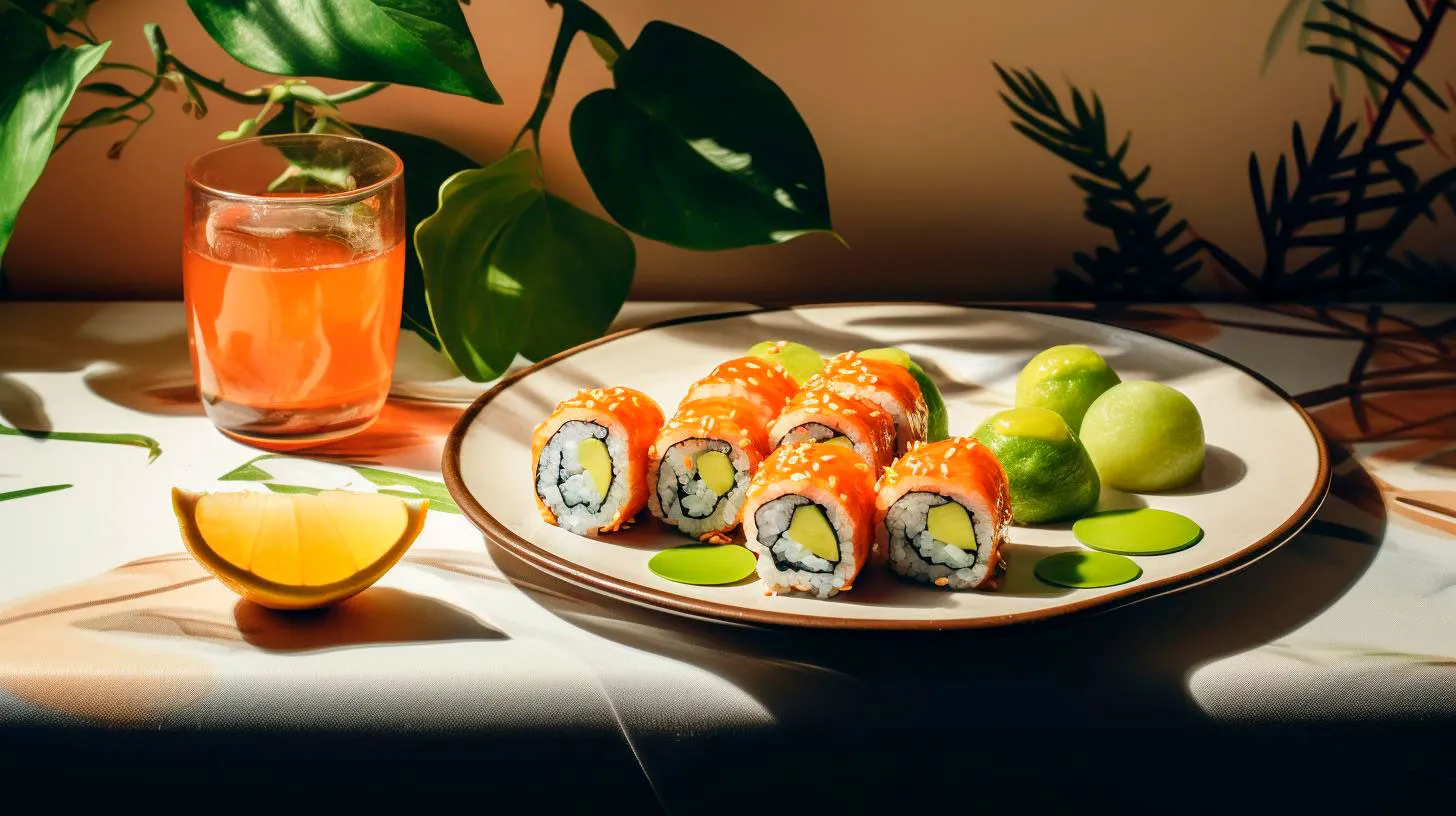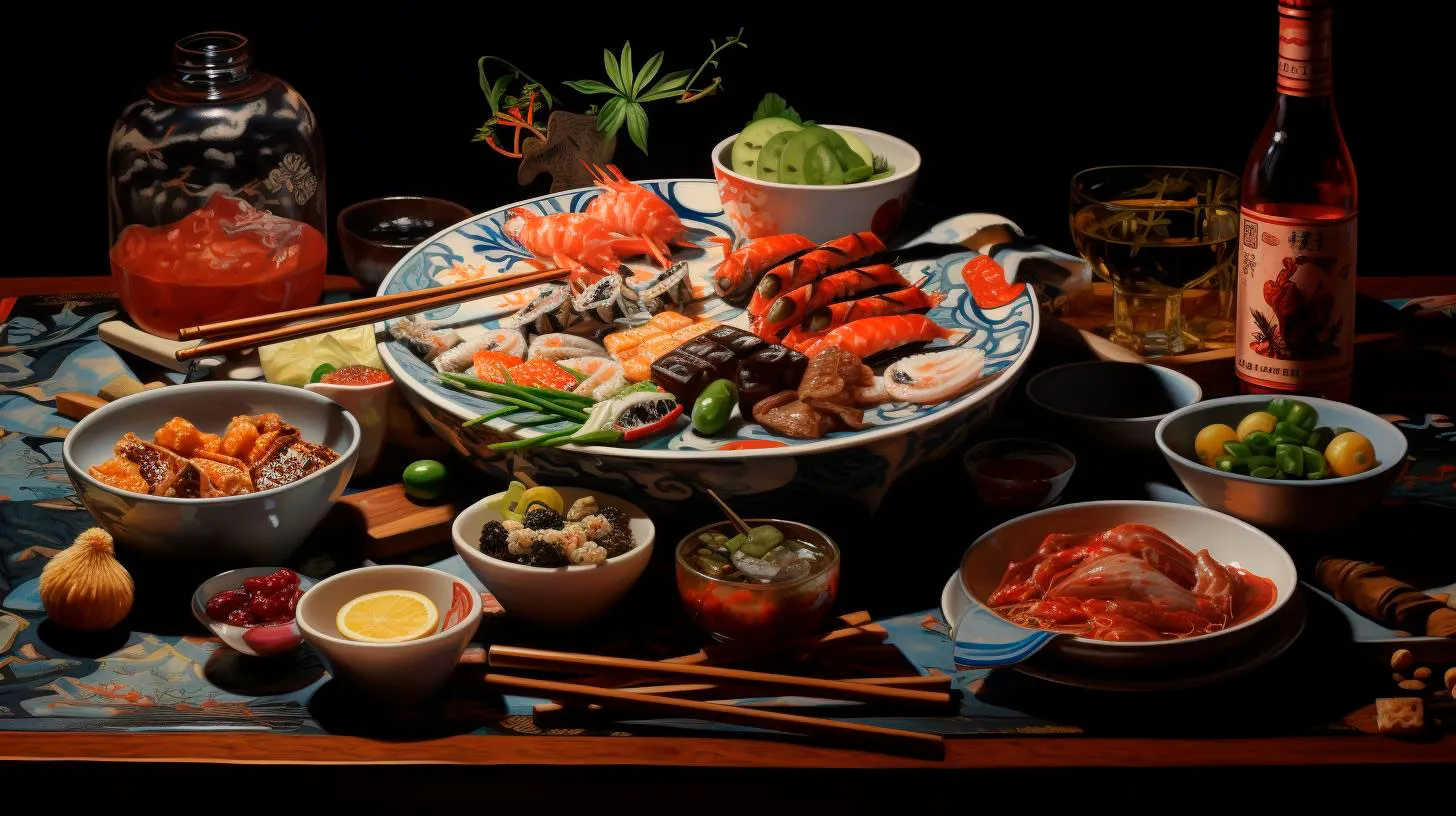Cultural Symbolism Metaphors in Japanese Culinary Literature
In this article, we will explore the cultural symbolism metaphors found in Japanese culinary literature and delve into the intriguing world of Japanese gastronomy.
A Taste of Tradition
Japanese cuisine is intricately connected with the country’s traditions, values, and customs. It is through food that the Japanese express their respect for nature, appreciation for simplicity, and their strong sense of unity with each other. The cultural symbolism metaphors embedded in Japanese culinary literature beautifully capture these notions, adding depth to each dish.
1. Rice: The Essence of Life
Rice, known as “gohan” in Japanese, is the staple food of Japan. It is not merely a source of sustenance; it embodies the concept of life itself. In Japanese culinary literature, rice often symbolizes the fundamental values of the country. It represents purity, fertility, and the interconnectedness of all living things. Just as each grain of rice relies on the others in the bowl, the Japanese believe in the importance of community and harmony.
Key Takeaway: Rice is a powerful symbol in Japanese culinary literature, representing purity, fertility, and community.
2. Sakura: The Transience of Beauty
The sakura, or cherry blossom, holds a significant place in Japanese culture. In culinary literature, the fleeting existence of cherry blossoms is often used as a metaphor for the transience of life. Just as the delicate blossoms bloom for a short period, Japanese cuisine emphasizes the appreciation of the present moment. Through seasonal dishes featuring cherry blossoms, the Japanese express their gratitude for nature’s beauty and the impermanent nature of life.
Key Takeaway: The sakura symbolizes the impermanence of life and encourages gratitude for nature’s beauty.
3. Tea Ceremony: Balance and Harmony
The tea ceremony, or “chanoyu,” is a ritualistic practice that showcases the meticulous attention to detail and pursuit of harmony in Japanese culture. In Japanese culinary literature, the tea ceremony is often used as a metaphor for finding balance in one’s life. Just as each step in the tea ceremony is performed with utmost precision, the preparation and presentation of a meal in Japanese cuisine aim to achieve harmony of flavors, textures, and aesthetics.
Key Takeaway: The tea ceremony represents the pursuit of balance and harmony, which is reflected in the meticulous preparation of Japanese cuisine.
A Delectable Journey
Exploring Japanese culinary literature offers a fascinating journey through the country’s diverse regional cuisines and their associated cultural symbolism metaphors. Let’s delve into some specific dishes and their hidden meanings:
1. Sushi: Simplicity and Authenticity
Sushi, the internationally renowned Japanese dish, is a masterpiece that embodies the values of simplicity and authenticity. In culinary literature, sushi often symbolizes the pursuit of perfection through minimalism. The elegant combination of fresh fish and hand-pressed vinegared rice represents the harmony between land and sea, celebrating the abundance of the ocean and the bountiful rice fields. Sushi also emphasizes the importance of using the freshest, highest quality ingredients, allowing their natural flavors to shine.
Key Takeaway: Sushi represents simplicity, authenticity, and the harmony between land and sea.
2. Matcha: Tranquility and Zen
Matcha, a finely ground powdered green tea, is not just a beverage in Japanese culinary literature; it is an embodiment of tranquility and Zen philosophy. Matcha rituals, such as the tea ceremony, highlight the importance of being fully present in the moment. Matcha tea symbolizes a state of calmness, focus, and meditation. Each sip brings a sense of serenity and stimulates the mind, making it a perfect companion during moments of reflection and contemplation.
Key Takeaway: Matcha represents tranquility, focus, and a state of Zen-like calmness.
An Ongoing Legacy
Japanese culinary literature is a treasure trove of cultural symbolism metaphors that continue to inspire and educate. By understanding the deeper meanings behind the dishes, we can appreciate not just the flavors but also the stories they convey. The use of these metaphors in Japanese cuisine showcases the country’s reverence for nature, pursuit of balance, and celebration of life’s fleeting beauty.
Exploring Japanese culinary literature is a journey that not only expands our gastronomic knowledge but also deepens our understanding of a vibrant and captivating culture.
Key Takeaway: Japanese culinary literature offers a profound insight into the country’s traditions, values, and customs, making it a fascinating exploration of culture through the medium of food.
Taste with Tradition: Unveiling the Secrets of Japanese Gastronomy
In this article, we will delve into the secrets and unique aspects of Japanese cuisine, exploring its rich history, distinct ingredients, and the philosophy that makes it stand out.
The Rich History of Japanese Cuisine
Japanese gastronomy dates back thousands of years and is deeply rooted in ancient traditions. While influenced by neighboring countries like China and Korea, it has evolved into a distinct culinary culture. One of the key aspects of Japanese cuisine is its emphasis on using fresh, seasonal ingredients to create visually stunning and flavorsome dishes.
Key takeaways:
- Japanese cuisine has a rich and ancient history.
- It is influenced by neighboring countries but has developed its own unique identity.
- The use of fresh, seasonal ingredients is a fundamental principle.
The Essence of Umami
Umami, often referred to as the fifth taste alongside sweet, sour, bitter, and salty, is a fundamental concept in Japanese cuisine. Coined by Japanese scientist Kikunae Ikeda in the early 20th century, umami represents a savory, pleasant taste that enhances the overall flavor profile of dishes. This unique taste is achieved through the use of ingredients such as dashi (a stock made from kombu seaweed and bonito flakes), miso paste, and soy sauce.
Key takeaways:
- Umami is a crucial element of Japanese cuisine.
- It adds a savory taste that enhances flavors.
- Ingredients like dashi, miso paste, and soy sauce contribute to umami.
The Art of Sushi
Sushi, arguably the most famous Japanese dish worldwide, showcases the meticulous craftsmanship and attention to detail found in Japanese gastronomy. Traditionally, sushi involves combining vinegared rice with various seafood or vegetables. The artistry lies in the precise technique of forming the rice and expertly pairing it with ingredients to create a balanced and delightful experience for the senses.
Key takeaways:
- Sushi is a globally recognized Japanese delicacy.
- It requires skillful preparation and presentation.
- The balance of flavors and textures is essential in sushi.
The Comfort of Ramen
A steaming bowl of ramen has the power to warm both body and soul. This iconic Japanese dish is beloved for its delectable flavors and versatility. From rich, pork-based tonkotsu broth to refreshing and tangy shoyu broth, ramen offers an array of options to satisfy every palate. Topped with succulent slices of chashu pork, a perfectly cooked egg, and an abundance of other toppings, ramen is an experience that cannot be missed.
Key takeaways:
- Ramen is a comforting and versatile dish.
- It comes in a variety of broths, each with its own unique flavor profile.
- Toppings play a crucial role in enhancing the ramen experience.
The Serenity of Matcha
Steeped in tradition, matcha is a powdered green tea that holds a special place in Japanese culture. With its vibrant green color and bitter-sweet flavor, matcha is not only enjoyed as a beverage but also incorporated into various desserts and sweets. Known for its calming and antioxidant properties, it is often used in traditional tea ceremonies, where the ritual and serenity surrounding matcha are revered.
Key takeaways:
- Matcha is a powdered green tea with a unique flavor.
- It is used in both beverages and desserts.
- Matcha is closely tied to Japanese tea ceremonies and culture.
The Delights of Sake
No exploration of Japanese gastronomy is complete without mentioning sake, Japan’s revered rice wine. Sake, often referred to as “nihonshu,” is made through a fermentation process involving rice, water, yeast, and koji mold. With its diverse range of flavors and styles, sake has become increasingly popular worldwide. From dry and crisp to sweet and fruity, there is a sake to suit every palate and occasion.
Key takeaways:
- Sake is a traditional Japanese rice wine.
- It comes in various flavors and styles.
- Sake has gained international recognition and popularity.
In conclusion, Japanese gastronomy is a stunning blend of traditions, flavors, and meticulous craftsmanship. From the artistry of sushi to the comforting embrace of ramen, each dish tells a story of cultural heritage and culinary excellence. Exploring the secrets of Japanese cuisine opens doors to a world of taste sensations that will leave you longing for more.
Fusion of Flavors: Exploring the Art of Sushi
When it comes to sushi, there is no shortage of options. Whether you prefer the traditional nigiri or the modern sushi burritos, there is something for everyone. The fusion of flavors found in sushi not only offers a unique dining experience but also showcases the creativity and expertise of the sushi chefs.
Key Takeaways:
- Sushi is a globally popular culinary art form that combines flavors, textures, and visual presentation.
- Traditional nigiri and modern sushi burritos are just some of the many options available in the world of sushi.
- Sushi showcases the creativity and expertise of sushi chefs.
Exploring Traditional Sushi:
Traditional sushi is a true reflection of Japanese cuisine and culture. It is characterized by simplicity, precision, and attention to detail. Nigiri, which consists of a mound of rice topped with a slice of raw seafood, is one of the most iconic forms of traditional sushi. The delicate balance of flavors and textures in each bite is what sets it apart.
Another popular traditional sushi style is maki, or sushi rolls. These rolls are made by wrapping rice, seafood, and vegetables in a sheet of seaweed, also known as nori. Maki rolls often feature familiar ingredients like tuna, avocado, and cucumber, but can also incorporate more adventurous options like eel or sea urchin.
Key Features of Traditional Sushi:
- Simple and precise presentation.
- Delicate balance of flavors and textures.
- Use of fresh, high-quality ingredients.
Embracing Fusion Sushi:
Fusion sushi takes traditional sushi to new heights by incorporating global flavors and techniques. This modern twist on a classic offers a myriad of exciting combinations, attracting adventurous eaters and those looking for a fresh take on sushi.
One popular example of fusion sushi is the sushi burrito, which combines the convenience of a burrito with the flavors of sushi. These oversized rolls are filled with sushi rice, fresh fish or other proteins, and an array of colorful vegetables. The result is a portable and flavorful meal that delights the senses.
Another innovative fusion sushi creation is the rainbow roll, which showcases a vibrant assortment of sashimi wrapped around a traditional sushi roll. The diverse colors and flavors make it a feast for both the eyes and taste buds. This type of sushi truly exemplifies the artistry and creativity of sushi chefs.
Key Advantages of Fusion Sushi:
- Introduces new and exciting flavors to the traditional sushi palate.
- Offers a creative twist on classic ingredients.
- Enhances visual appeal with vibrant and colorful presentations.
The Growing Popularity of Sushi:
The popularity of sushi has soared globally in recent years. According to a report by Statista, the global sushi market was valued at over $13 billion in 2020, and it is projected to reach over $22 billion by 2027. This exponential growth can be attributed to several factors.
Firstly, sushi’s reputation as a healthy food choice has contributed to its rise in popularity. With its emphasis on fresh seafood, vegetables, and rice, sushi is often considered a nutritious and low-calorie option. Additionally, the beauty of sushi lies in its versatility, accommodating various dietary preferences such as vegetarian, gluten-free, and even vegan options.
Social media has also played a significant role in increasing sushi’s popularity. The visually appealing nature of sushi, especially fusion creations, makes it highly shareable on platforms like Instagram. Influencers and food bloggers regularly showcase their sushi experiences, generating buzz and curiosity among their followers.
Key Statistics:
- The global sushi market was valued at over $13 billion in 2020 and is projected to reach over $22 billion by 2027.
- Sushi’s reputation as a healthy food choice has contributed to its rise in popularity.
- Social media has played a significant role in increasing sushi’s popularity.
Whether you are a sushi aficionado or a curious foodie, exploring the world of sushi is a delightful adventure. From traditional nigiri to fusion creations, each bite offers a fusion of flavors that is truly unique. So, gather your chopsticks and embark on a culinary journey that will transport you to the rich and colorful world of sushi.
Satori: The Spiritual Enlightenment in Japanese Cuisine
In this article, we delve into the essence of satori and how it shapes the unique flavors, presentation, and cultural significance of Japanese cuisine.
The Art of Mindful Eating
Satori goes beyond mere fulfillment of hunger; it emphasizes the importance of being present in the moment and fully appreciating the food in front of us. In Japanese culture, each meal is an opportunity to engage all the senses and achieve a sense of tranquility and harmony. This mindful approach to eating encourages us to savor each bite, to appreciate the effort and craftsmanship behind the meal, and to connect with the natural world that provides us with sustenance.
Key Takeaways:
- Mindful eating is a crucial aspect of Japanese cuisine
- Satori promotes being present in the moment while enjoying food
- Appreciating the effort and craftsmanship behind meals
- Connecting with nature through the food we consume
Umami: The Fifth Taste
One of the fundamental characteristics of Japanese cuisine is the concept of umami – the fifth taste that complements sweet, sour, salty, and bitter. Umami is often described as savory and mouthwatering and is abundant in ingredients such as seaweed, miso, soy sauce, and bonito flakes. It is the taste that awakens our taste buds and connects us to the essence of the dish. The quest for umami perfection is a driving force behind the meticulous preparation and careful selection of ingredients in Japanese cooking.
Key Takeaways:
- Umami is the fifth taste that enhances the flavor of Japanese cuisine
- Seaweed, miso, soy sauce, and bonito flakes are umami-rich ingredients
- The pursuit of umami perfection influences ingredient selection
Delicate Presentation: A Feast for the Eyes
In Japanese cuisine, the presentation of a dish is just as important as its taste. Every plate is meticulously arranged to create a visual masterpiece that evokes a sense of harmony, balance, and appreciation for nature. From the elegant sushi rolls to the artful arrangement of a kaiseki meal, Japanese chefs take great pride in transforming simple ingredients into visually stunning works of art.
Key Takeaways:
- Japanese cuisine places great importance on the visual presentation
- Each dish is meticulously arranged for balance and harmony
- Japanese chefs take pride in transforming simple ingredients into culinary art
Health and Well-being
The spiritual aspect of Japanese cuisine is closely tied to the pursuit of health and well-being. Traditional Japanese meals are often rich in fresh seafood, seasonal vegetables, and fermented foods, providing a myriad of health benefits. From boosting the immune system to promoting gut health, Japanese cuisine is grounded in the belief that food is medicine, and mindful eating can lead to a balanced and healthy lifestyle.
Key Takeaways:
- Japanese cuisine promotes health and well-being through its ingredients
- Fresh seafood, seasonal vegetables, and fermented foods offer numerous health benefits
- Mindful eating contributes to a balanced and healthy lifestyle
Conclusion
Japanese cuisine encompasses a profound spiritual journey that transcends the act of eating. Through the principles of satori and mindful eating, the beauty of Japanese food lies not only in its incredible flavors but also in the connections it fosters between humans, nature, and the wider universe. As we explore the rich world of Japanese cuisine, let us embark on our own journey towards satori, finding spiritual enlightenment one bite at a time.


